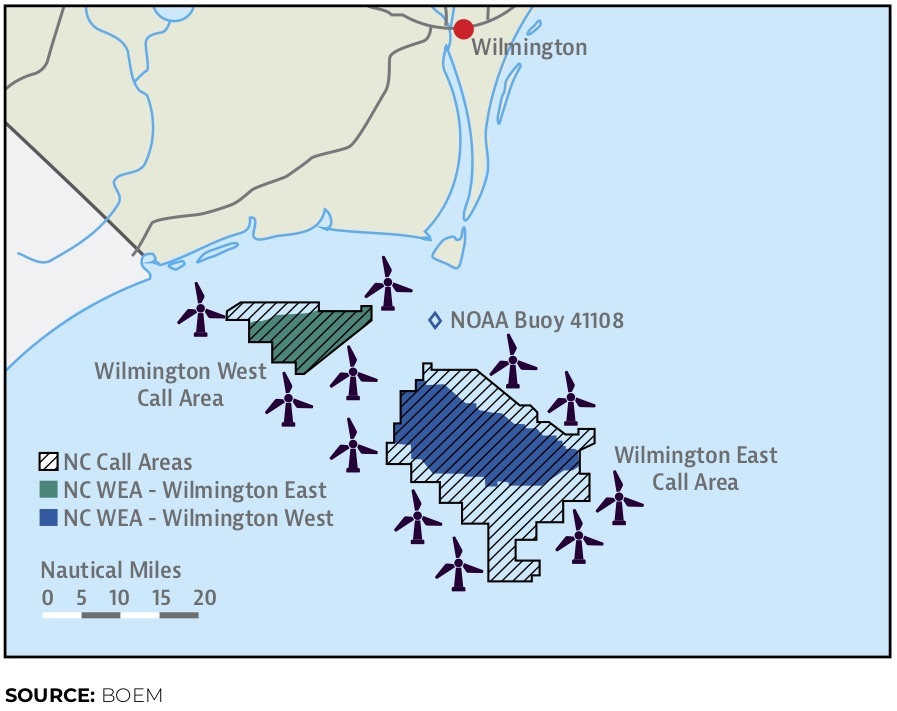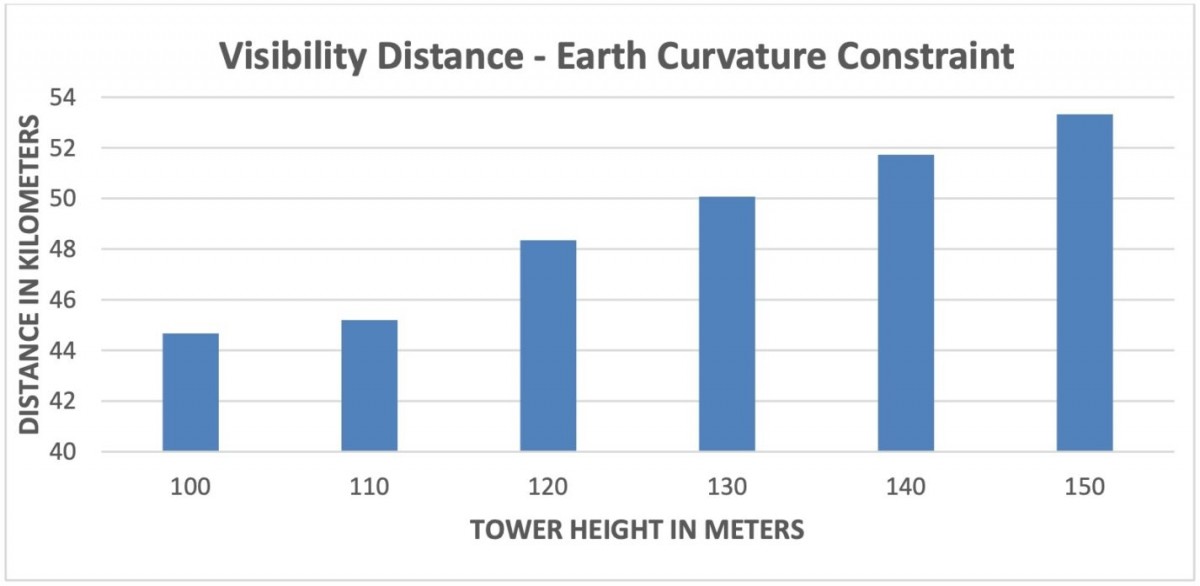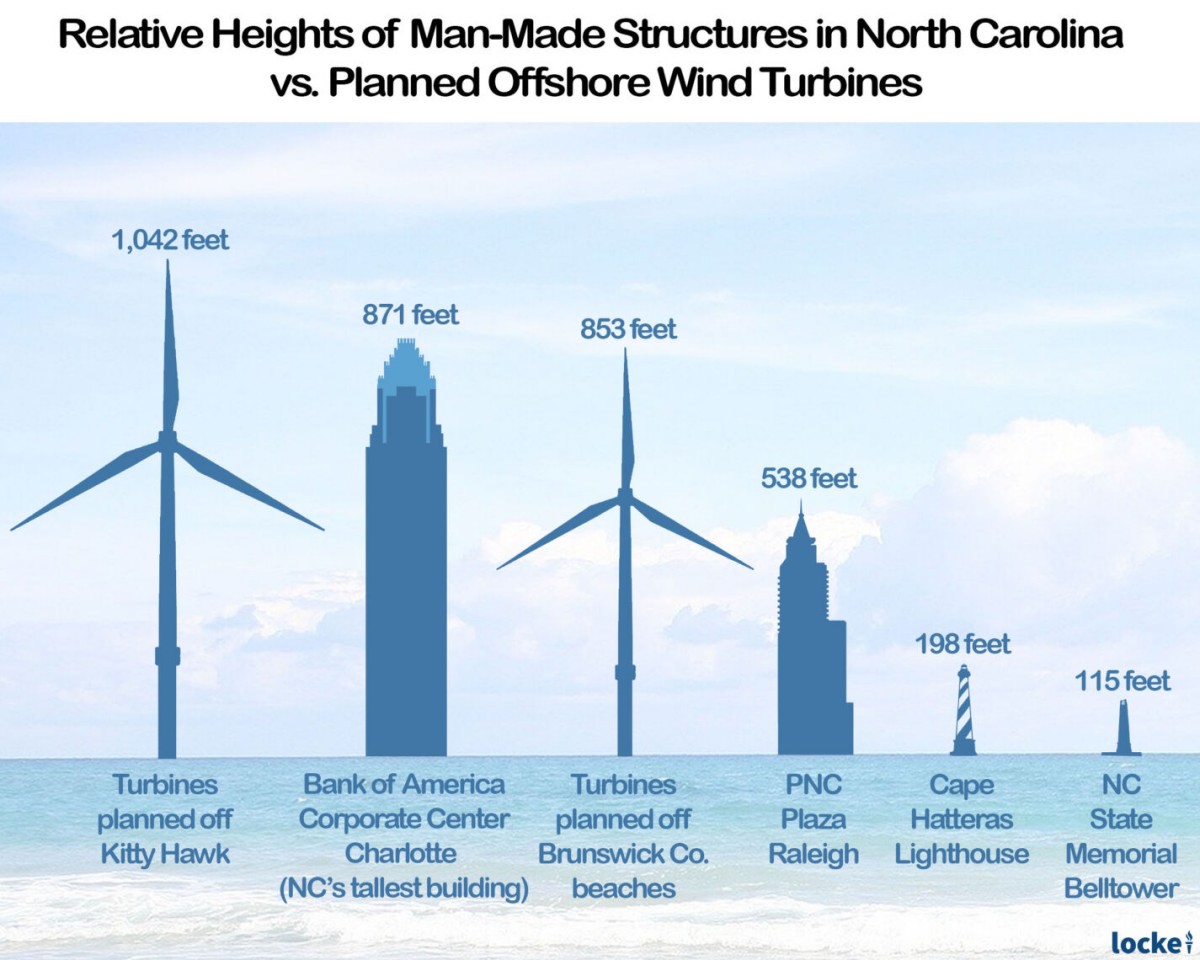In Difficult Times Good People gravitate towards Absolute Truth
Massive Offshore Wind Turbines with Flashing Lights Would Be Major Features on the Coastal Horizon
Publisher's Note: This post appears here courtesy of the John Locke Foundation. The author of this post is Jon Sanders.
Offshore wind energy facilities fielding vast arrays of huge wind turbines would ruin the crystal blue horizon that vacationers prize. Tourism is one of the two top industries in coastal communities (the other is fishing, which is also severely threatened by offshore wind).
Nevertheless, in his first week in office, Pres. Joe Biden threw caution to the wind and ordered a "goal of doubling offshore wind by 2030," following it up by announcing "bold actions that will catalyze offshore wind energy ... up and down the Atlantic Coast" and bring about "rapid offshore wind deployment." In line with those orders, Gov. Roy Cooper soon afterward ordered the State of North Carolina to "strive" to develop 8.0 gigawatts of offshore wind capacity by 2040.
Wilmington East and Wilmington West offshore wind energy areas ("Carolina Long Bay") and proximity to shore

North Carolina coastal communities that would be affected by these rash political goals have significant economic concerns. Recently, officials in the Biden and Cooper administrations teamed up with wind energy advocacy groups and sympathetic media to try to tamp them down.
On March 21, Cooper's "N.C. Taskforce for Offshore Wind Economic Resource Strategies" (NC Towers) brought "industry experts, academics, and government officials" to try to quell Brunswick County residents' concerns about offshore wind. From the sounds of it from WRAL's "climate change reporter," attendees to the presentation were made to think that the turbines would be barely visible. For example:
Katharine Kollins, president of the non-profit Southeastern Wind Coalition (SEWC), says residents would likely only be able to see the turbines with binoculars.
Only with binoculars? That's simply not accurate at all. There are plenty of reasons to expect large wind turbine arrays a few nautical miles offshore to be arresting features on the horizon, destroying residents' views and sending tourists to unspoiled coastlines in other states.
BOEM viewshed analysis, 2015
In 2015, viewshed analysis for New York offshore wind projects conducted for the U.S. Bureau of Ocean Energy Management (under Pres. Barack Obama) had shown that, from most vantage points, wind turbines up to 24 nautical miles (NM) off shore would "strongly attract[] the visual attention of views" owing to their "strong contrast" to the horizon - and from some vantage points wind turbines would "dominate" the view. These problems, the BOEM study noted, would be worse at night because of the lights attached to the turbine blades and towers to alert aircraft.
It's important to point out that the BOEM viewshed analysis was of turbines 577 feet tall, from sea level to blade tip. The turbines currently in discussion off the Brunswick beaches (for the "Carolina Long Bay," also called the Wilmington East and West wind energy areas) would be 853 feet tall. Turbines being discussed in the Kitty Hawk wind energy area would be 1,042 feet tall. It's not unlikely that those taller turbines might later be chosen for the Carolina Long Bay area.
If turbines at 577 feet tall would be so visually arresting from areas up to 24 nautical miles, then arrays of turbines that are 48 to 80 percent taller and within 20 nautical miles would not suddenly require binoculars to see. Especially not at night.
BOEM offshore lighting guidance, 2016
In 2016, a study conducted for BOEM for determining lighting guidance for offshore wind towers and blade tips noted that it was "physically possible (assuming clear daytime conditions and excellent acuity on the part of the viewer) for the tops of the nacelles of wind turbines of tower heights ranging from 100 to 150 m to be seen from approximately 44-53 km (23.5-27.8 NM) over water before they fall below the physical horizon (adjusted for refraction)." This finding does not even account for "visibility at night when lamps are lit."
In other words, BOEM found that turbines as small as 328 to 492 feet tall could be seen unaided on a clear day from as far away as 23.5 to 27.8 nautical miles. Again, the turbines in discussion off the coast of North Carolina range in height from 853 to 1,042 feet tall.
The following graphs were included in that BOEM report:
Effect of Earth Curvature on Visibility (Includes Refraction) - BOEM Illustration

Visibility Distances of Offshore Wind Turbines, By Height (Includes Refraction)
* Note: Turbine heights in this graph range from 328 to 492 feet, and distances range from 23.5 to 27.8 nautical miles

Visibility of lighthouses
Some objects are intended to be seen at sea level across long distances: lighthouses, which are erected across the coastline to help mariners navigate and avoid dangerous shoals. Perhaps the most iconic lighthouse in North Carolina is the Cape Hatteras Lighthouse. It is 198 feet tall and reaches 210 feet above mean sea level.
In other words, the Cape Hatteras Lighthouse is not even one-fourth the height of the turbines planned off the shores of Brunswick County, and not even one-fifth the height of the turbines planned for the Kitty Hawk wind energy area.

How far away can the Cape Hatteras Lighthouse be seen? According to its National Park Service page,
The official range is 24 nautical miles (a nautical mile is 6,080 feet). At night, most vessels in clear weather can see the lighthouse from up to 20 nautical miles at sea. Seen exactly at sea level, the direct visible range is about 15.6 nautical miles. The USLHS standard was to allow an extra ten feet of height to account for the height of the bridge deck, giving 16.2 miles. At night, the glow or loom can be seen when the light is actually below the horizon; in some atmospheric conditions refraction causes the light to follow the earth's curvature, too. These phenomena are also factored in. The range of the lighthouse depends more on height and air clarity than on the power of its beacon.
So someone could see a light atop a tower 210 feet above sea level for up to 20 nautical miles. That's the same distance Brunswick County residents were told they'd need binoculars for seeing towers 853 feet above sea level.
It's tempting to think that the intensity of the beacon is the deciding factor, but the human eye is extraordinarily perceptive of light. Research from Texas A&M University, discussed in MIT Technological Review, has shown that the human eye can readily distinguish a candle's flame up to 1.6 miles away. As the National Park Service points out, the range of the lighthouse is more dependent on its height (and a clear sky).
The wind turbines would more than quadruple the lighthouse's height - and they would be required to be fitted with lights on the towers and blade tips that all flash simultaneously 30 times per minute in all directions.
Conclusion
Coastal residents have significant reasons to worry about viewshed disruption from large arrays of enormous wind turbines off the coast - regardless of what self-interested government officials and advocacy groups try to tell them.
The next brief in this series will delve more into viewshed disruption by offshore wind turbines and estimate how visible they could be.
Go Back
- Recently, federal and state government officials and wind energy advocates tried to quell Brunswick County residents' serious economic concerns about offshore wind turbines spoiling ocean views and harming tourism
- Earlier federal government reports found there would be significant viewshed disruption - and by much smaller turbines than would be used now
- The Cape Hatteras Lighthouse is visible at the same distance coastal residents were told they'd need "binoculars" to see wind turbines over four times its height
Offshore wind energy facilities fielding vast arrays of huge wind turbines would ruin the crystal blue horizon that vacationers prize. Tourism is one of the two top industries in coastal communities (the other is fishing, which is also severely threatened by offshore wind).
Nevertheless, in his first week in office, Pres. Joe Biden threw caution to the wind and ordered a "goal of doubling offshore wind by 2030," following it up by announcing "bold actions that will catalyze offshore wind energy ... up and down the Atlantic Coast" and bring about "rapid offshore wind deployment." In line with those orders, Gov. Roy Cooper soon afterward ordered the State of North Carolina to "strive" to develop 8.0 gigawatts of offshore wind capacity by 2040.
Wilmington East and Wilmington West offshore wind energy areas ("Carolina Long Bay") and proximity to shore

North Carolina coastal communities that would be affected by these rash political goals have significant economic concerns. Recently, officials in the Biden and Cooper administrations teamed up with wind energy advocacy groups and sympathetic media to try to tamp them down.
On March 21, Cooper's "N.C. Taskforce for Offshore Wind Economic Resource Strategies" (NC Towers) brought "industry experts, academics, and government officials" to try to quell Brunswick County residents' concerns about offshore wind. From the sounds of it from WRAL's "climate change reporter," attendees to the presentation were made to think that the turbines would be barely visible. For example:
Katharine Kollins, president of the non-profit Southeastern Wind Coalition (SEWC), says residents would likely only be able to see the turbines with binoculars.
Only with binoculars? That's simply not accurate at all. There are plenty of reasons to expect large wind turbine arrays a few nautical miles offshore to be arresting features on the horizon, destroying residents' views and sending tourists to unspoiled coastlines in other states.
BOEM viewshed analysis, 2015
In 2015, viewshed analysis for New York offshore wind projects conducted for the U.S. Bureau of Ocean Energy Management (under Pres. Barack Obama) had shown that, from most vantage points, wind turbines up to 24 nautical miles (NM) off shore would "strongly attract[] the visual attention of views" owing to their "strong contrast" to the horizon - and from some vantage points wind turbines would "dominate" the view. These problems, the BOEM study noted, would be worse at night because of the lights attached to the turbine blades and towers to alert aircraft.
It's important to point out that the BOEM viewshed analysis was of turbines 577 feet tall, from sea level to blade tip. The turbines currently in discussion off the Brunswick beaches (for the "Carolina Long Bay," also called the Wilmington East and West wind energy areas) would be 853 feet tall. Turbines being discussed in the Kitty Hawk wind energy area would be 1,042 feet tall. It's not unlikely that those taller turbines might later be chosen for the Carolina Long Bay area.
If turbines at 577 feet tall would be so visually arresting from areas up to 24 nautical miles, then arrays of turbines that are 48 to 80 percent taller and within 20 nautical miles would not suddenly require binoculars to see. Especially not at night.
BOEM offshore lighting guidance, 2016
In 2016, a study conducted for BOEM for determining lighting guidance for offshore wind towers and blade tips noted that it was "physically possible (assuming clear daytime conditions and excellent acuity on the part of the viewer) for the tops of the nacelles of wind turbines of tower heights ranging from 100 to 150 m to be seen from approximately 44-53 km (23.5-27.8 NM) over water before they fall below the physical horizon (adjusted for refraction)." This finding does not even account for "visibility at night when lamps are lit."
In other words, BOEM found that turbines as small as 328 to 492 feet tall could be seen unaided on a clear day from as far away as 23.5 to 27.8 nautical miles. Again, the turbines in discussion off the coast of North Carolina range in height from 853 to 1,042 feet tall.
The following graphs were included in that BOEM report:
Effect of Earth Curvature on Visibility (Includes Refraction) - BOEM Illustration

Visibility Distances of Offshore Wind Turbines, By Height (Includes Refraction)
* Note: Turbine heights in this graph range from 328 to 492 feet, and distances range from 23.5 to 27.8 nautical miles

Visibility of lighthouses
Some objects are intended to be seen at sea level across long distances: lighthouses, which are erected across the coastline to help mariners navigate and avoid dangerous shoals. Perhaps the most iconic lighthouse in North Carolina is the Cape Hatteras Lighthouse. It is 198 feet tall and reaches 210 feet above mean sea level.
In other words, the Cape Hatteras Lighthouse is not even one-fourth the height of the turbines planned off the shores of Brunswick County, and not even one-fifth the height of the turbines planned for the Kitty Hawk wind energy area.

How far away can the Cape Hatteras Lighthouse be seen? According to its National Park Service page,
The official range is 24 nautical miles (a nautical mile is 6,080 feet). At night, most vessels in clear weather can see the lighthouse from up to 20 nautical miles at sea. Seen exactly at sea level, the direct visible range is about 15.6 nautical miles. The USLHS standard was to allow an extra ten feet of height to account for the height of the bridge deck, giving 16.2 miles. At night, the glow or loom can be seen when the light is actually below the horizon; in some atmospheric conditions refraction causes the light to follow the earth's curvature, too. These phenomena are also factored in. The range of the lighthouse depends more on height and air clarity than on the power of its beacon.
So someone could see a light atop a tower 210 feet above sea level for up to 20 nautical miles. That's the same distance Brunswick County residents were told they'd need binoculars for seeing towers 853 feet above sea level.
It's tempting to think that the intensity of the beacon is the deciding factor, but the human eye is extraordinarily perceptive of light. Research from Texas A&M University, discussed in MIT Technological Review, has shown that the human eye can readily distinguish a candle's flame up to 1.6 miles away. As the National Park Service points out, the range of the lighthouse is more dependent on its height (and a clear sky).
The wind turbines would more than quadruple the lighthouse's height - and they would be required to be fitted with lights on the towers and blade tips that all flash simultaneously 30 times per minute in all directions.
Conclusion
Coastal residents have significant reasons to worry about viewshed disruption from large arrays of enormous wind turbines off the coast - regardless of what self-interested government officials and advocacy groups try to tell them.
The next brief in this series will delve more into viewshed disruption by offshore wind turbines and estimate how visible they could be.





















